2011 Ford Mustang V6 – Click above for high-res image gallery
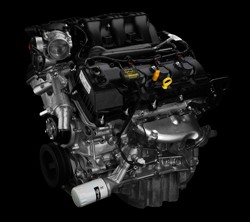 It would be reasonable to expect that Ford might pass over the Mustang and instead devote more attention to its other models since it's fresh off a comprehensive revamp for the 2010 model year. However, that's not what is shaping up in the House That Henry Built.
It would be reasonable to expect that Ford might pass over the Mustang and instead devote more attention to its other models since it's fresh off a comprehensive revamp for the 2010 model year. However, that's not what is shaping up in the House That Henry Built.
For 2011, the Blue Oval is introducing a new 3.7-liter V6 Mustang that should give it the firepower and refinement needed to take on Chevrolet's six-cylinder Camaro and Hyundai's upstart Genesis Coupe. But it isn't just the spanking all-aluminum powerplant and its 305 horsepower and 280 foot-pounds of torque that's making the scene for the forthcoming model year. In addition to the Cleveland-sourced mill, there are a pair of fresh gearboxes, a new V6 performance package, and a host of nip/tucks to the interior and elsewhere.
Now, we could grouse on behalf of 2010 MY 'Stang owners everywhere that these upgrades weren't part of last year's mid-life updo, but instead, we'll just be happy that these advancements are arriving at all.
Despite being smaller than the outgoing 4.0-liter V6, the dual-overhead cam 3.7-liter's horsepower and torque ratings represent massive improvements over the 2010 model (305 HP dismisses 210 HP and 280 lb-ft. plays 240 torques). In fact, that's more horsepower than the 4.6-liter V8 Mustang made just a few years ago. While the 305-horse figure only allows the Mustang to pip the crosstown Camaro by a single all-important stallion in the pony car bragging wars, Ford says the powertrain will be good for 30 miles-per-gallon on the highway when paired with its new six-speed automatic, also one notch better than the Chevy.
Click through to the jump to read more details and check out Ford's suite of press releases.
[Source: Ford]
That impressive fuel economy figure isn't just the result of the new engine – a suite of new pieces have been developed in order to maximize performance, including a revised air intake, a pair of new six-speed transmissions (both automatic and manual), electric power steering, and even some aerodynamic tidying, including a revised front fascia, deeper front air dam, rear-wheel tire spats, different underbody shields, and a new rear decklid seal.
The Heart Transplant
Despite those incremental improvements, the centerpiece of the 2011 Mustang is obviously the 24-valve Duratec V6, and it includes Twin Independent Variable Camshaft Timing (Ti-VCT) and polished buckets and roller finger followers in the direct-acting mechanical bucket valvetrain, among other features. Ford officials promise that V6 buyers won't miss the roar of the V8's extra cylinders thanks to a retuned air intake and throaty standard dual exhaust. At the sneak-peek event for this new Mustang motor, Autoblog had the chance to hear the new engine fire up and rev – and it indeed sounds sporty and purposeful. To be fair, however, we only heard the powertrain briefly in an enclosed space (a large development garage on Ford's Dearborn campus), so we'll have to wait until it's out in the open and we're behind the wheel to really get a feel for the 3.7's aural character. Other noteworthy features of the drivetrain include a deep-sump aluminum oil pan that enables less-frequent 10,000-mile oil change intervals and a 7,000-RPM redline.
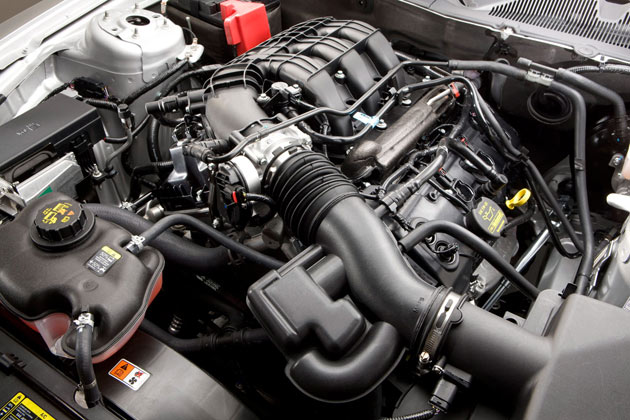
On the transmission front, Ford has fitted a new six-speed 6R60 automatic (with a special hill assist mode that reduces gear hunting) that allows for the 30 MPG highway bogey, as well as 19 MPG in the urban cycle (a 25 percent improvement over the 2010's 16 mpg city / 24 mpg highway figures). Prefer to shift for yourself? Expect fuel economy to suffer an iota for your enjoyment, with numbers for the six-speed manual falling to 18/29 (2010 MY: 18/26).
Naturally, with an all-new powertrain and its differing weight properties, Ford's engineers also had to turn their attention to the suspension. To that end, the 2011 V6 gets new damper and spring rates, a different rear lower control arm, and stiffer stabilizer bar bushings.
A More Electrifying Steer?
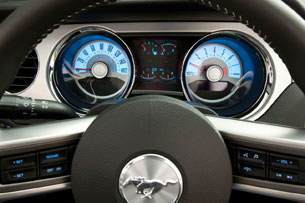
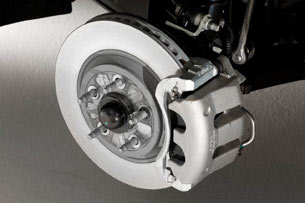
We always get a bit nervous when vehicles move to electronic power steering. Such systems may improve performance by lowering parasitic drag on the engine, but they rarely do any favors for steering feel. Ford assures us that they've worked hard to build a robust "feedback loop" into the system, but again, we'll have to wait and see for ourselves. In the meantime, we'll remain curious about how effective Ford's so-called Pull-Drift Compensation system is at accounting for road crowns and crosswinds, not to mention the amusingly named Active Nibble Control, which apparently helps to exorcise high-speed vibrations caused by wheel balance issues and warped brake rotors. And about those brakes – they're bigger. 11.5-inches in front and 11.8-inchers out back have been borrowed from the GT's parts bin, and there's also a standard limited-slip differential to help get the V6 model's newfound power to the ground.
The Performance Model
What V6 Mustang are we most eager to drive? The new Performance Package model, which is scheduled to go on sale next August, as it promises to provide increased grip and go. For starters, the Perf Pack borrows the uprated front struts and rear shocks/springs from the V8 GT model, along with its thicker front and rear anti-roll bars and the rear lower control arms from the Shelby GT500. Also included is a 3.31 axle ratio for better acceleration, model-specific 19-inch alloys wrapped in Pirelli summer rubber, more lenient stability control programming with a dedicated sport mode, as well as a strut tower brace and the usual assortment of badges.
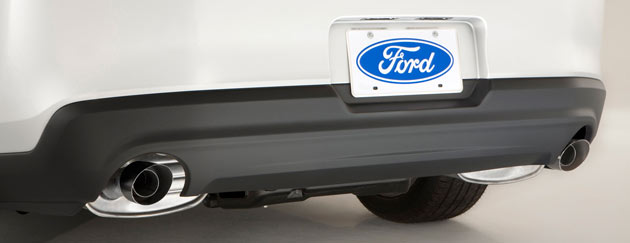
How will street spotters identify the new V6 Mustang? If the dual exhaust isn't enough of a tip-off, you'll probably have to check the glass. For 2011, all Mustangs get nifty integrated blind-spot mirrors – and if you peek inside the driver's side window, you might catch a glimpse of the new-look instrument cluster which features a 160 MPH speedo and an 8,000-RPM tach.
How Much – and What's Next?
Ford has yet to release any performance estimates or pricing, but despite the big jump in power and content, we don't expect pricing to increase dramatically. Given that the augmented V6 nearly shades the current 4.6-liter V8's horsepower figure (and the fact that the latter engine is comprehensively outgunned by the Camaro SS' 6.2-liter engine's 426 hp and 420 pound-feet of torque, it's no surprise that a new V8 engine is rumored, and we fully expect to see it before this domestic auto show season is out.
The takeaway from all of this? For those who thought that the rekindled pony car wars reached a fever pitch this year with the advent of the refreshed Mustang, long-awaited Camaro and still-warm Dodge Challenger, well... we ain't seen nothin' yet.
PRESS RELEASES:
2011 Ford Mustang V-6 goes high-tech: new 305-Hp engine, six-SPEED transmission expected to Deliver 30 MPG highway
• For 2011, Mustang makes sports coupe news with a new high-performance, all-aluminum Duratec® 3.7-liter DOHC Ti-VCT V-6 that delivers 305 horsepower and an expected best-in-class 30 mpg highway with six-speed automatic transmission – no other vehicle in the industry can beat that combination
• Six-speed transmissions – manual and automatic – combine with newly standard limited-slip differential and revised suspension for road-carving driving dynamics and handling
• New technology and convenience features include: Standard integrated spotter mirrors; message center; MyKey™ programmable vehicle key; and Universal Garage Door Opener
Dearborn, Mich., Nov. 30, 2009 – The 2011 Ford Mustang puts 305 high-performance horses in the hands of V-6 coupe buyers with a new all-aluminum dual-overhead cam (DOHC) engine that delivers a projected 30 mpg on the highway with a six-speed automatic transmission and fun for drivers on nearly every road.
For 2011, Mustang's new 3.7-liter Duratec 24-valve V-6 uses advanced engineering to deliver its power and economy: Twin Independent Variable Camshaft Timing (Ti-VCT) adjusts the valvetrain in microseconds. Aluminum construction means light weight. It's an engine designed to crank out torque down low, rev to 7,000 rpm and deliver the mechanical music sports coupe lovers crave everywhere in between.
"Mustang is completely transformed with this new engine," said Derrick Kuzak, group vice president, Global Product Development. "Everything people love about the car is still there and now under the hood is a V-6 engine that uses premium technology to deliver the power, the feel, the fuel efficiency, even the sound of the best sports coupes in the world."
New 3.7-liter V-6 engine
With Ti-VCT operating its four valves per cylinder, the new Mustang V-6 powerplant sends significantly more horsepower and torque (305 hp and 280 ft.-lb.) to the rear wheels than its predecessor – despite its smaller displacement. The behind-the-wheel feel is unlike any Mustang ever produced.
"This new V-6 engine really speaks to what Mustang is all about," said Barb Samardzich, Ford vice president of global powertrain engineering. "It produces power everywhere in the rev range and loves to be pushed hard. The Duratec 3.7-liter builds on our promise to use advanced technology to deliver both power and fuel economy."
The high output is due largely to Ti-VCT which allows variable control of valve operation across the rev range. The variable cams operate on a Direct Acting Mechanical Bucket (DAMB) valvetrain using polished buckets and roller finger followers to reduce friction. The end result is as much as a 3 percent improvement in fuel economy and a 10 percent improvement in power output versus traditional engines without these advanced features.
Ti-VCT is complemented by special-tuned composite upper and lower intake manifolds for efficient air delivery and lighter weight. Ignition power is delivered by a high-energy coil-on-plug design, while piston-cooling jets and a lightweight die-cast aluminum cylinder block improve the durability and efficiency of the 3.7-liter V-6 design.
Performance was the mantra for every aspect of engine design. A cold air induction system and dual exhaust give the 3.7 its free-breathing style with a 7,000 rpm redline and near-instantaneous response to throttle inputs.
A die-cast aluminum deep-sump oil pan provides 10,000-mile oil change intervals, saving drivers money on maintenance and resulting in less waste in oil disposal.
Engineers also worked to ensure aggressive, high-performance sounds come from the new engine, from intake to exhaust. Not only does the retuned air intake system minimize losses, it also provides the driver with a satisfying intake rush on hard acceleration. The all-new dual exhaust system is mellow at idle but opens up with a howl at full-tilt, letting Mustang drivers know they're behind the wheel of a world-class sports coupe.
"This car marks a new type of Mustang," said David Pericak, Mustang chief nameplate engineer. "We're using a high-performance quad-cam V-6 with all the bells and whistles in a car that's become legendary for its handling and roadholding; it's really going to get a lot of new sports coupe fans excited about Mustang, some for the first time ever."
Powertrain improvements
Drivers can get the most out of the new V-6 engine's output using either an all-new six-speed manual gearbox or a six-speed automatic transmission. Both come with the flexibility and fuel economy benefits of six forward ratios regardless of whether buyers want to shift for themselves or not.
Drivers who prefer a manual gearbox will enjoy the short throws and direct feel of the shifter along with the relaxed cruising permitted by the extra top gear ratio. Customers choosing the automatic will be pleasantly surprised to find the advanced six-speed 6R60 transmission does not sacrifice fuel economy – or performance – for convenience, delivering an expected 30 mpg highway with crisp, quick shifts that maximize torque and horsepower.
The automatic transmission also features a grade-assist or "hill mode" to improve drivability on hilly terrain. This technical innovation uses vehicle input – acceleration, pedal position, vehicle speed and brake status – to automatically determine the correct gear ratio while on an incline or decline. Hill mode eliminates sixth gear, extends lower gear operation on uphill climbs, and provides additional grade or engine braking for coast downs.
The standard 2.73 rear axle provides an ideal blend of cruising fuel economy and acceleration, aided by the wide ratio spread permitted through the use of six forward speeds in the gearboxes. Performance enthusiasts can select an available 3.31 rear axle ratio for better off-the-line launch characteristics.
Fuel economy improvements
Extra horsepower and refined engine operation will be the most noticeable features to new 2011 Mustang 3.7-liter V-6 buyers while projected class-leading fuel economy, also a standard feature, offers an additional bonus. The numbers speak for themselves:
• 19 mpg city/30 highway with six-speed automatic transmission, up from 16 mpg city/ 24 highway on the 2010 model with automatic – a 25 percent improvement over 2010
• 18 mpg city/29 highway with six-speed manual transmission, up from 18 mpg city/26 highway on the 2010 model with manual
Refinements throughout Mustang's body, powertrain and chassis design contribute to the improved fuel economy numbers. Examples include:
• The new Electric Power Assist Steering (EPAS) system which eliminates the drag of an engine-operated hydraulic power steering pump
• Six-speed transmissions that allow lower cruising revs without sacrificing off-the-line performance
• Aerodynamic improvements such as a new front fascia, tire spats on the rear wheels, modified underbody shields, a taller air dam and an added rear decklid seal
Handling and driving dynamics
With so much additional horsepower standard, the 2011 Mustang received enhancements to its chassis to maintain the outstanding balance and driving behavior Mustang owners expect. Damper tuning and spring rates were revised to provide a smooth highway ride while a new rear lower control arm and stiffened stabilizer bar bushings improve stiffness and handling for better cornering response.
While Mustang's aerodynamic improvements were designed mainly to improve fuel economy, engineers also adjusted the vehicle's front/rear lift balance. The result is a car that tracks more securely and feels more "planted" to the road surface at higher speeds, helping to keep the tires in better contact with the pavement.
The addition of EPAS marks a new era in driving dynamics for Mustang owners. Steering effort at parking lot speeds is reduced, while high-speed and highway feel is improved for more precise steering and handling. Because the belt-driven power steering pump is eliminated, EPAS provides a quieter vehicle with fewer components drawing engine power.
EPAS also enables new technologies that adjust for minor driving annoyances. Pull-Drift Compensation adjusts the steering to correct for crosswinds and minor road crowning, while Active Nibble Control helps eliminate the "shimmy" felt at high speeds when a wheel is out of balance or a brake rotor is warped. Both conditions are alleviated by EPAS independent of driver input, helping ensure Mustang delivers a smooth, comfortable driving experience in all conditions.
Mustang buyers choosing the new V-6 will also get a standard limited-slip differential that provides better handling and more sure-footed grip in poor weather conditions by directing engine torque to the rear wheel with the most traction. When the time comes to slow things down, the 2011 Mustang is also equipped with larger four-wheel ABS disc brakes, with 11.5 inch front and 11.8 inch rear rotors.
Refinements complement advanced features
To reinforce the sporty nature of the 2011 Mustang, all V-6 models will come standard with new instrument cluster graphics, including a speedometer that reads up to 160 mph and a tachometer that reads to 8,000 rpm, reflecting the free-revving style of the new engine.
Additional lightweight soundproofing measures help filter unpleasant, high-frequency noises while tuned intake and dual exhaust add the sounds Mustang buyers relish.
Occupants also benefit from new door seals and a rear wheel arch liner that reduce road noise for a quieter, more enjoyable drive, all with minimal weight gain compared to the 2010 model.
Enthusiasts who want a premium performance-oriented Mustang V-6 can opt for the new Performance Package, which will be available August 2010. Designed for driving enthusiasts, the Mustang V-6 Performance Package comprises:
• A 3.31 rear axle ratio for quicker off-the-line acceleration
• Firmer Mustang GT suspension
• 19-inch wheels
• Summer performance tires for improved grip
• A strut tower brace for increased chassis rigidity
• Unique electronic stability control calibration with sport mode for performance driving
For 2011, Mustang also ups the ante on technology and convenience features, including a standard driver's message center in the instrument cluster and integrated blind-spot mirrors in the side-view mirror housings.
Ford's MyKey™ system, designed to encourage safer teen driving and safety belt use, also is newly available on Mustang. MyKey allows owners to program the vehicle key using the driver's message center to incorporate features such as limited top vehicle speed and audio volume, a traction control system that cannot be deactivated, a persistent Belt-Minder® safety belt reminder and various speed alert chimes.
Top safety marks expected
Mustang's technological advances are also incorporated in the structure of the vehicle to improve safety. The 2010 Mustang coupe earned the U.S. government's top five-star crash-test rating, a designation the 2011 model is expected to achieve.
The Mustang's considerable body stiffness contributes to the coupe and convertible's driving performance and has a parallel benefit in accident protection. While the coupe's body structure is approximately 31 percent stiffer than the previous Mustang platform, the convertible's is more than twice as stiff – creating a structure that helps protect the cabin from deformation and intrusion in an impact.
Mustang also uses high-strength steel in its body structure and ultra-high-strength steel in the door intrusion beams for additional side-impact protection.
The front structure's crush zones are computer-designed to absorb energy in a controlled manner and help dissipate it before it can reach the passenger compartment. Ford engineers have run thousands of design iterations of the Mustang's front rails to arrive at an octagonal shape that helps spread crash forces evenly to aid in protecting occupants.
State-of-the-art technology adds to the convenience and safety of the 2011 Mustang, from the availability of the latest version of Ford SYNC®, with applications such as Traffic, Directions and Information, 911 Assist™ and Vehicle Health Report, to standard AdvanceTrac® Electronic Stability Control, which complements the all-speed traction control and standard Anti-lock Braking System (ABS).
Additional standard safety equipment includes the Personal Safety System™ which features dual-stage driver and front passenger air bags, safety belt pretensioners and Belt-Minder.
The 2011 Mustang will be built at the Auto Alliance International Plant in Flat Rock, Mich. The new 3.7-liter V-6 will be built at Ford's recently retooled Cleveland Engine Plant No. 1.
# # #
Twin Independent Variable Camshaft Timing (Ti-VCT) Helps make 2011 Ford Mustang v-6 a true thoroughbred
• Ti-VCT technology key to Mustang's new 3.7-liter V-6 engine's flexibility, delivering 305 horsepower and a projected 30 mpg highway with six-speed automatic transmission – no other vehicle in the industry can beat that combination
• Variable camshaft timing uses oil pressure to adjust valve opening and closing events, providing improved off-the-line acceleration over non-VCT equipped engines
• Variable valve overlap from Ti-VCT provides better fuel economy and emissions, along with optimized cold-start operation vs. conventional engines
Dearborn, Mich., Nov. 30, 2009 – The heart of every Mustang is its engine, and beneath the hood of the new 2011 Ford Mustang V-6 beats a technological tour de force. Displacing 3.7 liters, the dual-overhead-camshaft (DOHC) 24-valve V-6 uses Ford's Twin Independent Variable Camshaft Timing (Ti-VCT) to produce 305 horsepower and 280 ft.-lb. of torque and is projected to deliver up to 30 mpg highway – a combination unbeaten by any other vehicle in the industry.
Customer benefits of Ti-VCT include extremely precise variable control of "valve overlap," or the window of time in which both the intake and exhaust valves in the engine are open simultaneously.
"This overlap control via Ti-VCT helps us eliminate compromises in the induction and exhaust systems," said Jim Mazuchowski, Ford manager of V-6 powertrain operations. "Drivers are going to notice improved low-speed torque and increased fuel economy and peak horsepower. Plus, there are benefits they won't notice, too, such as reduced emissions overall, especially at part-throttle."
The flexibility allowed by Ti-VCT means Mustang V-6 customers will experience:
• Better off-the-line launch feel, with plenty of the low-end "grunt" for which Mustang is famous. Ti-VCT can deliver up to a 5 percent improvement in low-end torque and a 7 percent improvement in peak power versus non-Ti-VCT-equipped engines.
• Improved fuel economy at all engine speeds resulting in projected 19 mpg city/30 highway with six-speed automatic transmission; 18 mpg city/29 highway with six-speed manual transmission. Ti-VCT alone can account for up to a 4.5 percent fuel economy improvement over non-VCT-equipped engines.
• Lower emissions, with better control of NOx and HC throughout the range of engine operating speeds, reducing atmospheric pollution.
How the technology works
As a DOHC design, the 3.7-liter V-6 uses two camshafts per cylinder bank – one to open the intake valves and one to open the exhaust valves. Traditionally, camshafts only have been able to open the valves at a fixed point defined during engine design and manufacturing. But with modern variable cam timing systems, the camshafts can be rotated slightly relative to their initial position, allowing the cam timing to be "advanced" or "retarded."
Ti-VCT takes this technology and applies it to both the intake and exhaust camshafts of its DOHC design, using electronic solenoid valves to direct high-pressure oil to control vanes in each of the camshaft sprocket housings. By using one valve per camshaft, controlled by the Electronic Control Module (ECM), each intake and exhaust cam can be advanced or retarded independently of the other as engine operating conditions change, providing an exceptional degree of valve timing control.
The new 3.7-liter engine for the 2011 Mustang V-6 will be built at Ford's recently retooled Cleveland Engine Plant No. 1.
# # #
2011 Ford Mustang V-6 performance package boosts handling, braking; CAR NOW ROAD-COURSE READY
• All-new 2011 Mustang V-6 joins the ranks of performance-tuned Mustang offerings worldwide; available Performance Package combines lightweight 305-horsepower all-aluminum V-6, a 3:31 performance rear axle and Mustang GT-based suspension and braking components
• Unique 19-inch wheels and Pirelli performance tires provide superb grip and aggressive appearance
• Electronic stability control calibration features Sport mode for high-performance driving and track-oriented events
Dearborn, Mich., Nov. 30, 2009 – Around the globe, Ford's performance-tuned cars are known to provide an uncompromised driving experience in a remarkably civilized package. Growing from that tradition, the new 2011 Ford Mustang V-6 will offer an optional factory-installed Performance Package that combines high-tech horsepower and a taut suspension in a package that will appeal to track-day fans and sports car aficionados alike.
Powered by the same 305-horsepower all-aluminum Ti-VCT V-6 as the new 2011 Mustang, the Performance Package takes advantage of the new engine's lightweight and high-revving nature to deliver a nimble performance car equally at home on a road course or a road trip.
"The new Performance Package delivers on fast, fun and affordable, combining the all-new 2011 V-6 with Mustang GT prowess," said Dave Pericak, Mustang chief nameplate engineer. "It's a true sports car for the new generation and a smart choice for the environmentally-conscious enthusiast. It is a perfect marriage of power, performance and value."
Borrowing from the Mustang GT, the Performance Package includes numerous suspension, braking and body stiffening upgrades to deliver unparalleled handling performance. That road-holding is helped by a near-equal front/rear weight distribution, providing exceptional transient response along with the car's slimmed-down curb weight of less than 3,500 pounds.
2011 Mustang Performance Package upgrades include:
• A 3.31 rear axle ratio for quicker off-the-line acceleration
• Mustang GT coupe front and rear stabilizer bars
• Mustang GT front struts and rear shocks/springs
• Shelby GT500 rear lower control arm
• Unique 19-inch wheels
• Pirelli performance tires for improved grip
• Mustang GT front and rear brake calipers with Performance Friction pads
• A strut tower brace for increased body rigidity
• Unique electronic stability control calibration with Sport mode for performance driving
• Unique badging
The 2011 Mustang V-6 Performance Package will be available beginning late next summer, built at the Auto Alliance International Plant in Flat Rock, Mich. The new 3.7-liter V-6 will be built at Ford's retooled Cleveland Engine Plant No. 1.
# # #
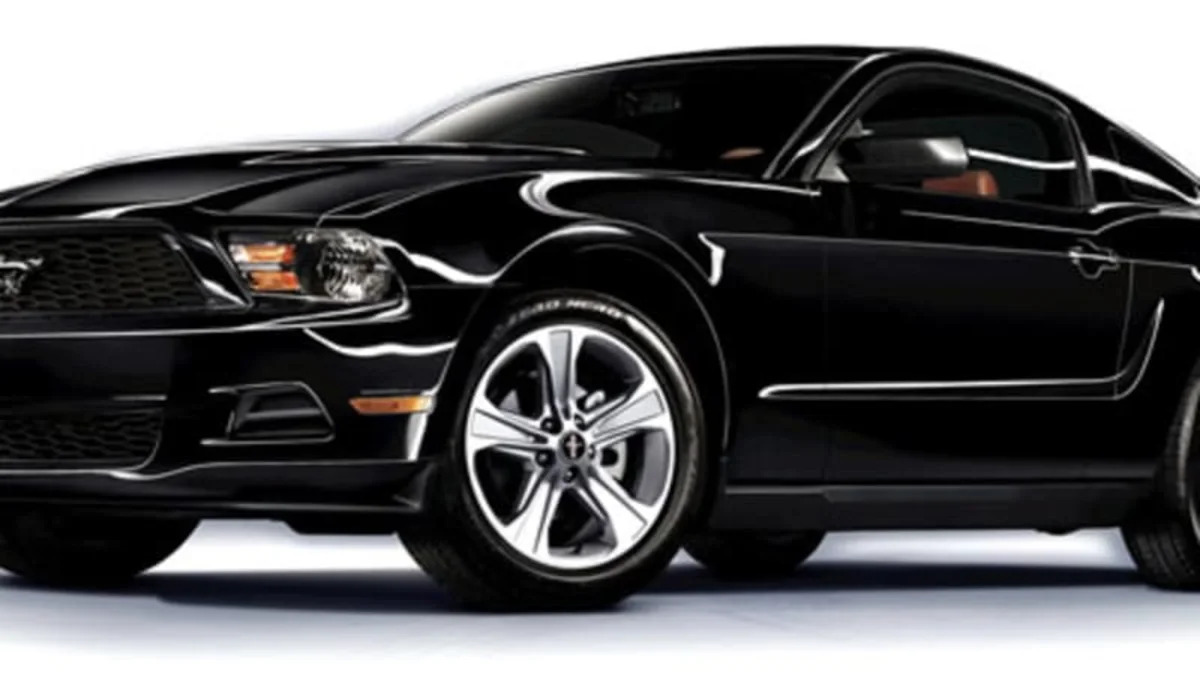

Sign in to post
Please sign in to leave a comment.
Continue